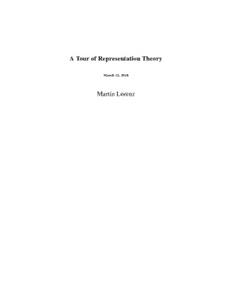
A Tour of Representation Theory PDF
Preview A Tour of Representation Theory
A Tour of Representation Theory March12,2018 Martin Lorenz 2010MathematicsSubjectClassification. Primary16Gxx,16Txx,17Bxx, 20Cxx,20Gxx For Maria Contents Preface xi Conventions xvii PartI. Algebras Chapter1. RepresentationsofAlgebras 3 1.1. Algebras 3 1.2. Representations 24 1.3. PrimitiveIdeals 41 1.4. Semisimplicity 50 1.5. Characters 65 Chapter2. FurtherTopicsonAlgebras 79 2.1. Projectives 79 2.2. FrobeniusandSymmetricAlgebras 96 PartII. Groups Chapter3. GroupsandGroupAlgebras 113 3.1. Generalities 113 3.2. FirstExamples 124 3.3. MoreStructure 131 3.4. SemisimpleGroupAlgebras 142 3.5. FurtherExamples 150 3.6. SomeClassicalTheorems 159 vii viii Contents 3.7. Characters,SymmetricPolynomials,andInvariantTheory 170 3.8. DecomposingTensorPowers 179 Chapter4. SymmetricGroups 187 4.1. Gelfand-ZetlinAlgebras 189 4.2. TheBranchingGraph 192 4.3. TheYoungGraph 197 4.4. ProofoftheGraphIsomorphismTheorem 205 4.5. TheIrreducibleRepresentations 217 4.6. TheMurnaghan-NakayamaRule 222 4.7. Schur-WeylDuality 235 PartIII. LieAlgebras Chapter5. LieAlgebrasandEnvelopingAlgebras 245 5.1. LieAlgebraBasics 246 5.2. TypesofLieAlgebras 254 5.3. ThreeTheoremsaboutLinearLieAlgebras 257 5.4. EnvelopingAlgebras 266 5.5. GeneralitiesonRepresentationsofLieAlgebras 278 5.6. TheNullstellensatzforEnvelopingAlgebras 287 5.7. Representationsofsl 300 2 Chapter6. SemisimpleLieAlgebras 315 6.1. CharacterizationsofSemisimplicity 316 6.2. CompleteReducibility 320 6.3. CartanSubalgebrasandtheRootSpaceDecomposition 325 6.4. TheClassicalLieAlgebras 334 Chapter7. RootSystems 341 7.1. AbstractRootSystems 342 7.2. BasesofaRootSystem 349 7.3. Classification 356 7.4. LatticesAssociatedtoaRootSystem 361 Chapter8. RepresentationsofSemisimpleLieAlgebras 373 8.1. Reminders 374 8.2. Finite-DimensionalRepresentations 377 8.3. HighestWeightRepresentations 379 Contents ix 8.4. Finite-DimensionalIrreducibleRepresentations 385 8.5. TheRepresentationRing 390 8.6. TheCenteroftheEnvelopingAlgebra 393 8.7. Weyl’sCharacterFormula 408 8.8. SchurFunctorsandRepresentationsofsl(V) 418 PartIV. HopfAlgebras Chapter9. Coalgebras,BialgebrasandHopfAlgebras 427 9.1. Coalgebras 427 9.2. Comodules 441 9.3. BialgebrasandHopfAlgebras 446 Chapter10. RepresentationsandActions 465 10.1. RepresentationsofHopfAlgebras 466 10.2. FirstApplications 476 10.3. TheRepresentationRingofaHopfAlgebra 485 10.4. ActionsandCoactionsofHopfAlgebrasonAlgebras 492 Chapter11. AffineAlgebraicGroups 503 11.1. AffineGroupSchemes 503 11.2. AffineAlgebraicGroups 508 11.3. RepresentationsandActions 512 11.4. Linearity 515 11.5. IrreducibilityandConnectedness 520 11.6. TheLieAlgebraofanAffineAlgebraicGroup 526 11.7. AlgebraicGroupActionsonPrimeSpectra 530 Chapter12. Finite-DimensionalHopfAlgebras 541 12.1. FrobeniusStructure 541 12.2. TheAntipode 549 12.3. Semisimplicity 552 12.4. DivisibilityTheorems 558 12.5. Frobenius-SchurIndicators 566 Appendices AppendixA. TheLanguageofCategoriesandFunctors 575 A.1. Categories 575 x Contents A.2. Functors 578 A.3. Naturality 579 A.4. Adjointness 583 AppendixB. BackgroundfromLinearAlgebra 587 B.1. TensorProducts 587 B.2. Hom-⊗ Relations 593 B.3. VectorSpaces 594 AppendixC. SomeCommutativeAlgebra 599 C.1. TheNullstellensatz 599 C.2. TheGenericFlatnessLemma 601 C.3. TheZariskiTopologyonaVectorSpace 602 AppendixD. TheDiamondLemma 605 D.1. TheGoal 605 D.2. TheMethod 606 D.3. FirstApplications 608 D.4. ASimplification 611 D.5. ThePoincaré-Birkhoff-WittTheorem 612 AppendixE. TheSymmetricRingofQuotients 615 E.1. DefinitionandBasicProperties 615 E.2. TheExtendedCenter 617 E.3. ComparisonwithOtherRingsofQuotients 619 Bibliography 623 SubjectIndex 635 IndexofNames 647 Notation 651 Preface In brief, the objective of representation theory is to investigate the different ways inwhichagivenalgebraicobject—suchasanalgebra,agroup,oraLiealgebra— can act on a vector space. The benefits of such an action are at least twofold: the structure of the acting object gives rise to symmetries of the vector space on whichitacts;and,intheotherdirection,thehighlydevelopedmachineryoflinear algebracanbebroughttobearontheactingobjectitselftohelpuncoversomeofits hiddenproperties. Besidesbeingasubjectofgreatintrinsicbeauty,representation enjoys the additional benefit of having applications in myriad contexts other than algebra, ranging from number theory, geometry and combinatorics to probability and statistics [58], general physics [198], quantum field theory [210], the study of moleculesinchemistry[49]and,morerecently,machinelearning[126]. Thisbookhasevolvedfrommylecturenotesforatwo-semestergraduatecourse titledRepresentationTheorythatIgaveatTempleUniversityduringtheacademic years 2012/13 and 2015/16. Some traces of the informality of my original notes andthestyleofmylectureshaveremainedintact: thetextmakesrathercopioususe of pictures and expansively displayed formulae; definitions are not numbered and neither are certain key results, such as Schur’s Lemma or Wedderburn’s Structure Theorem, which are referred to by name rather than number throughout the book. However,duetotherestrictionsimposedbyhavingtosetforththematerialonthe page in a linear fashion, the general format of this book does not in fact duplicate my actual lectures and it only locally reflects their content. I will comment more onthisbelow. The title A Tour of Representation Theory (ToR) is meant to convey the panoramic view of the subject that I have aimed for.1 Rather than offering an 1ThechoiceoftitleisalsoanodtotheTourdeFrance,and“Tor”inGermanis“gate”aswellas“goal” (scored)and“fool”. xi xii Preface in-depthtreatmentofoneparticulararea,ToRgivesanintroductiontothreedistinct flavorsofrepresentationtheory—representationsofgroups,Liealgebras,andHopf algebras—and all three are presented as incarnations of algebra representations. Thebookloopsrepeatedlythroughthesetopics,emphasizingsimilaritiesandcon- nections. Group representations, in particular, are revisited frequently after their initial treatment in Part II. For example, Schur-Weyl duality is first discussed in Section 4.7 and later again in 8.8; Frobenius-Schur indicators are introduced in §3.6.3inconnectionwiththeBrauer-FowlerTheoremandtheyaretreatedintheir propergeneralityinSection12.5;andChapter11,onaffinealgebraicgroups,brings together groups, Lie algebras, and Hopf algebras. This mode of exposition owes muchtothe“holistic”viewpointofthemonograph[72]byEtingofetal.,although ToR forgoes the delightful historical intermezzos that punctuate [72] and it omits quiversinfavorofHopfalgebras. Ourtourdoesnotventureveryfarintoanyofthe areasitpassesthrough,butIhopethatToRwillengenderinsomereadersthedesire topursuethesubjectandthatitwillprovideaplatformforfurtherexplorations. OverviewoftheContents. ThetopicscoveredinToRandthemethodsemployed ∗ areresolutelyalgebraic. Liegroups,C -algebrasandotherareasofrepresentation theory requiring analysis are not covered. On the other hand, in keeping with the widely acknowledged truth that algebraic representation theory benefits from a geometric perspective, the discourse involves a modicum of algebraic geometry on occasion and I have also tried my hand at depicting various noncommutative geometricspacesthroughoutthebook. Nopriorknowledgeofalgebraicgeometry isassumed,however. Representations of algebras form the unifying thread running through ToR. Therefore, Part I is entirely written in the setting of associative algebras. Chap- ter 1 develops the basic themes of representation theory: irreducibility, complete reducibility, spaces of primitive ideals, characters, ...; the chapter establishes notationtobeusedthroughouttheremainderofthebook;anditfurnishesthefun- damental general results of representation theory, such as Wedderburn’s Structure Theorem. Chapter 2 covers topics that are somewhat more peripheral to the main thrustofToR:projectivemodules(Section2.1)andFrobeniusalgebras(Section2.2). Readers whose main interest is in groups or Lie algebras may skip this chapter at afirstreading. However,Section2.2deployssometoolsthatareindispensablefor thediscussionoffinite-dimensionalHopfalgebrasinChapter12. Parts II and III are respectively devoted to representations of groups and Lie algebras. To some degree, these two parts can be tackled in any order. However, Ihavemadeadeliberateeffortatpresentingthematerialongrouprepresentations inapalatablemanner,offeringitasanentrywaytorepresentationtheory,whilethe part on Lie algebras is written in a slightly terser style demanding greater math- ematical maturity from the reader. Most of Part II deals with finite-dimensional representationsoffinitegroups,usuallyoverabasefieldwhosecharacteristicdoes
